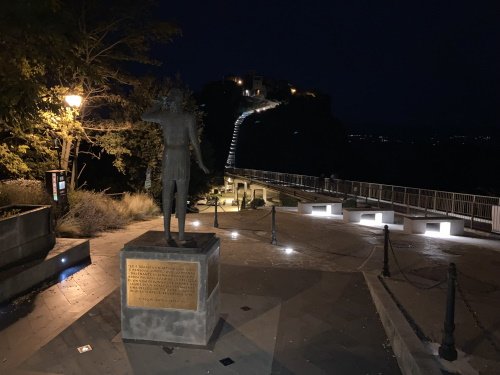When my
Art History friends
decided to have our annual get-together in Rome, I immediately extended the trip with a day to include
Civita di Bagnoregio
. This was supposed to be Italy’s nomination candidate for 2022 (now postponed to 2023). I stayed overnight in the core zone, a spooky experience as the place gets deserted at night. I arrived at the footbridge only at 7.30 pm; most of the approach was barely lit and neither was the village as only 16 people permanently live there. No restaurants are open in the evenings (at least not in October) and the owners of my B&B had left me the key at a hiding place.

Still, the people at the ticketing kiosk collecting the 5 EUR entrance fee to the village were at their post in the evening. The introduction of this fee for the 1 million yearly tourists has been a blessing for both Civita’s and Bagnoregio’s inhabitants, as communal taxes have been abolished for them since.
I explored Civita the next morning - it takes half an hour at most. There is one main street, which you can follow further down a bit towards a cave. The cave was used for burials by the Etruscans, but after the large earthquake of 1695, it was turned into a Roman Catholic chapel. The views from the village towards the surrounding landscape are quite picturesque, but overall I found the town more suitable for a ‘’Most Beautiful villages” award than WH status. Storywise the most similar WHS would be
Matera
, which I found much more spectacular in both its setting and history.

The classic photos of Civita, almost floating in the landscape, can be taken from the Belvedere viewpoint, which lies in the neighbouring town of Bagnoregio about 500m from the bridge. The town of Lubriano also has a good viewpoint: from there you can photograph the village from the side. All closer points will have the modern bridge prominently in view, and, honestly, the bridge isn’t that pretty.
In Bagnoregio, the Cathedral and the stretch of road leading towards Civita (including the bridge) will also be part of the nomination. The Cathedral supposedly has good frescoes, but I found it closed both in the evening and in the morning when I walked by.

Getting to Civita di Bagnoregio on public transport is quite a hassle, and when it gets inscribed a connection to the Rome hotspot is doubtable. The total net time needed is 2 hours and 40 minutes (1.5h train, 35 mins bus, 35 mins walking), but it takes a lot more when trains get delayed and you have to wait for one of the few Cotral buses that make the trip to Bagnoregio daily. My train from Rome Tiburtina to Orvieto had a delay of over an hour and I had to wait for the last bus of the day that leaves at 6.35 pm. Also, be aware that buses may leave early or just when the clock turns to the scheduled departure time. Tickets (also for the return) can be bought at the BON Italy coffee bar at Orvieto Scalo’s train station.



